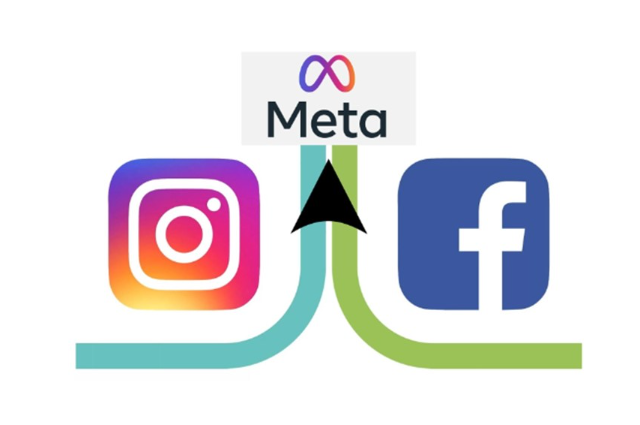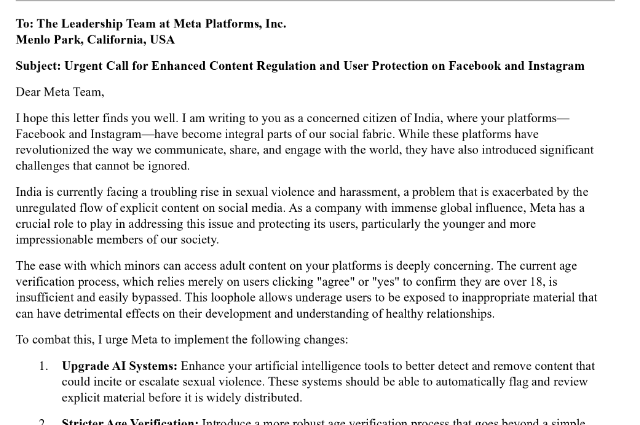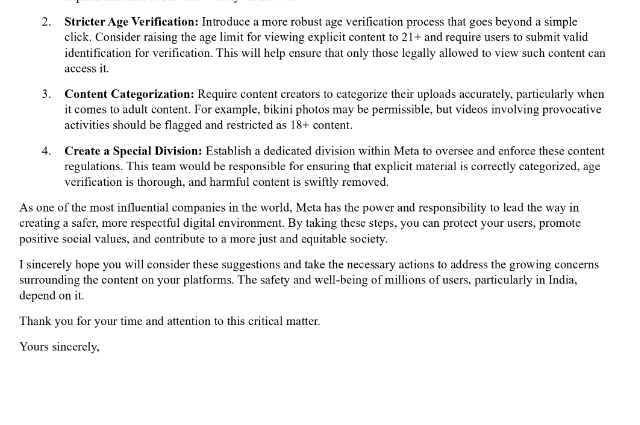
"In a country where over 90 rape cases are reported daily, social media platforms have become both a mirror and a magnifier of our society's darkest impulses. Explicit content, once hidden in the shadows, is now flaunted openly, influencing young minds and feeding into a culture of objectification and violence."
In India, platforms like Facebook and Instagram, both under the umbrella of Meta, have become central to our daily lives. However, the very spaces meant for social connection and expression are being misused to propagate content that is not only inappropriate but also dangerous. From nudity and pornographic posts to influencers flaunting unattainable beauty standards, the content that dominates these platforms is far from harmless. What’s worse is the ease with which young and impressionable users can access this material, leading to a myriad of social issues, including an increase in sexual violence.

Photo by Nipun Atik
As the digital age rapidly evolves, it’s imperative that platforms like Facebook and Instagram (Meta) to take responsibility and implement stricter regulations for the content they host. This article calls for the urgent need to regulate explicit content on social media, implement stricter controls to protect minors, and ensure that platforms do not contribute to the rising wave of sexual violence in India. Additionally, Meta needs an upgrade of its AI technology to effectively detect and delete posts that could incite or escalate sexual violence. Social media in India has become a breeding ground for harmful content, influencing young and adult minds negatively and contributing to a toxic culture.
Current State of Social Media
In today’s digital age, social media platforms like Facebook and Instagram have become central to our lives, shaping how we connect, share, and perceive the world around us. However, this connectivity comes with significant drawbacks, particularly in the form of explicit content that is increasingly prevalent on these platforms. What was once considered private or taboo is now displayed openly, often for the sake of gaining likes, followers, and monetary benefits.
Explicit content, including nudity and pornographic material, is alarmingly accessible on these platforms. Influencers and models, driven by the desire to monetize their online presence, frequently post provocative images and videos. This content often pushes the boundaries of decency, appealing to audiences with sensationalism rather than substance. As a result, social media has become a platform where the lines between acceptable and inappropriate content are frequently blurred.
This shift is especially concerning when it comes to younger users. Adolescents and teenagers, who are still in the process of forming their identities and understanding their sexuality, are exposed to unrealistic body standards and explicit material at an impressionable age. The constant bombardment of such content can distort their perceptions of beauty, relationships, and personal boundaries. Rather than providing a space for positive social interactions, these platforms sometimes become breeding grounds for unhealthy attitudes and behaviors.
The impact of this content extends beyond individual users and affects societal norms as well. Research has shown a troubling correlation between exposure to explicit content and an increase in sexual harassment and violence. The normalization of objectification and the trivialization of sexual acts contribute to a culture where disrespect and consent issues are more prevalent. In India, this issue is reflected in the alarming number of sexual violence cases reported daily—over 90—indicating a broader societal problem that social media is exacerbating rather than mitigating.
Moreover, the influence of social media on real-world behavior cannot be understated. The portrayal of violence and objectification as glamorous or desirable can lead to harmful real-life consequences. Young people, in particular, may develop skewed understandings of relationships and consent, influenced by the content they see online. This shift in perception can reinforce harmful stereotypes and perpetuate cycles of abuse and harassment.
Despite the growing concerns, current moderation practices on these platforms often fall short. Content that is flagged as inappropriate may not be removed promptly, and the mechanisms for reporting and dealing with such content can be inadequate. This lack of effective moderation allows harmful material to proliferate, impacting users' mental health and contributing to broader societal issues.
To address these problems, it is essential for social media platforms like Facebook and Instagram to take more robust actions. This includes implementing stricter content regulations, improving AI technologies to detect and remove harmful posts, and creating systems that limit the exposure of explicit material to younger users. One effective measure could be establishing a special division dedicated to verifying whether users are truly 18+ before they gain access to adult content. Currently, minors can easily bypass age restrictions by simply clicking “agree” or “yes” to confirm they are over 18, granting them unrestricted access to inappropriate material.
To combat this, the age threshold for viewing explicit content should be reconsidered, potentially raising it to 21+ to further protect young users. Additionally, platforms should employ AI-driven tools to verify users’ ages through more stringent methods, such as requiring valid ID proof before accessing adult content. Content creators should also be required to categorize their uploads accurately, distinguishing between general content and 18+ material. For instance, users who upload bikini photos might not trigger any restrictions, but if a video involves provocative activities like twerking, it should automatically be flagged and categorized as adult content, requiring age verification before viewing.
Overall, while social media has the potential to connect and inform, its current state often promotes harmful content that affects both individuals and society at large. Addressing these issues requires a concerted effort from both platform operators and policymakers to ensure that social media serves as a positive force rather than a source of harm.
The Need for Change
As social media continues to evolve, its impact on society becomes increasingly profound. Platforms like Facebook and Instagram, which are supposed to foster connections and provide entertainment, have inadvertently become breeding grounds for harmful content and behavior. The current state of these platforms, where explicit material and cyber harassment are rampant, calls for an urgent need for change—change that is not just cosmetic, but structural and systemic.
Regulation of Explicit Content
The first and most pressing need is the regulation of explicit content. The ease with which users, especially minors, can access adult material on social media is alarming. Current systems of age verification are woefully inadequate, often relying on simple "click to confirm" mechanisms that can be easily bypassed. This lack of effective control means that underage users are routinely exposed to content that is inappropriate and potentially harmful to their development.
To address this, there must be a comprehensive overhaul of the way explicit content is managed on social media platforms. This could include raising the age threshold for viewing explicit content to 21+ and implementing robust age verification processes that require users to provide verifiable identification before accessing such material. AI-driven tools could be employed to scan uploaded content for explicit material, categorizing it appropriately before it is made public. This would help prevent minors from being exposed to content that could negatively impact their mental and emotional well-being.
Content creators should be required to categorize their material at the point of upload. For example, if a user is uploading a bikini photo, it may not need to be restricted; however, if the content includes provocative actions, such as twerking, seducing, explicit condom ads or other suggestive behavior, it should be automatically flagged and categorized as 18+ content like X.com (formerly twitter) has it. This would ensure that users are not inadvertently exposed to material that could be deemed inappropriate or harmful.
Combatting Cyber Harassment
Another critical area that demands change is the handling of cyber harassment. Social media platforms have become hotbeds for abusive behavior, where anonymity and a lack of accountability embolden users to engage in harassment and threats. This has serious consequences, not just for the victims but for the overall tone and safety of online communities.
To tackle this issue, social media platforms need to implement more stringent measures against harassment. This includes developing sophisticated AI tools that can detect abusive language and threats in real-time, removing harmful posts before they spread. Additionally, platforms should introduce stricter penalties for those who engage in cyber harassment, including immediate suspension of accounts, reporting to law enforcement for severe cases, and a system of escalating consequences for repeat offenders.
There should also be a focus on educating users about the importance of online etiquette and the consequences of harassment. This could be achieved through mandatory tutorials or guidelines that users must agree to before they can interact on the platform.
The Role of META
As the parent company of both Facebook and Instagram, META has a unique responsibility to lead the charge in creating safer digital environments. META’s platforms are some of the most widely used in the world, and the policies they implement can set a standard for the entire industry.
META should begin by enhancing its content moderation capabilities. This means investing in more advanced AI systems that can better detect and manage explicit content, as well as human moderators who can review flagged content to ensure it is appropriately categorized and handled. Moreover, META should establish a dedicated division responsible for overseeing age verification processes, content categorization, and the implementation of stricter content regulations.
META’s responsibility extends beyond content moderation to include a moral obligation to its users. The company must recognize the profound influence it has on society and take proactive steps to ensure that its platforms do not contribute to the degradation of social norms or the perpetuation of harmful behavior. By leading with integrity and a commitment to user safety, META can not only protect its users but also restore trust in social media as a positive force in the world.
Public and Governmental Involvement
The need for change on social media platforms also requires the involvement of both the public and government entities. Users must demand higher standards from the platforms they use, and governments should step in to ensure that these platforms comply with regulations that protect public welfare. This could include legislation that mandates age verification processes, stricter penalties for platforms that fail to moderate harmful content, and the establishment of independent bodies to oversee social media practices.
Stricter Penalties for Violators
One of the most effective ways to maintain a safe and respectful online environment is to implement stricter penalties for those who violate community guidelines and engage in harmful behavior. Social media platforms must adopt a zero-tolerance approach to content that promotes violence, harassment, or any form of abuse. Stricter penalties not only act as a deterrent but also signal to the community that certain behaviors will not be tolerated.
Tiered Penalty System
A tiered penalty system could be introduced to ensure that violations are met with appropriate consequences based on their severity and frequency. The system could be structured as follows:
1. First Offense:
Warning and Temporary Ban: For minor violations, such as using offensive language or sharing borderline explicit content, the user could receive a warning along with a temporary ban (e.g., 24-48 hours). This would give the user time to reflect on their actions and understand the platform’s community guidelines.
2. Second Offense:
Longer Ban and Mandatory Education: If a user repeats the violation, the penalty should be more severe. A longer ban (e.g., 7-14 days) could be imposed, along with mandatory completion of an educational program on online safety and the impact of harmful behavior. This educational module could include videos, quizzes, and other interactive content designed to reinforce the importance of adhering to community standards.
3. Third Offense:
Permanent Ban and Account Removal: For users who continue to violate guidelines after two warnings, a permanent ban should be enforced. Their account would be removed, and they would be prohibited from creating new accounts under the same identity. Platforms could use advanced identification methods, such as IP tracking or device fingerprinting, to prevent banned users from simply creating new accounts and continuing their harmful behavior.
Preventing Evasion
To ensure that banned users do not evade penalties by creating new accounts, platforms should implement robust account verification systems. This could include multi-factor authentication, requiring users to verify their identity with a phone number, email, or even government-issued ID. For serious offenses, platforms could also share information with other social media companies, creating a unified blacklist of repeat offenders who are banned across multiple platforms.
Reporting to Law Enforcement
For severe cases, such as when a user makes rape threats, engages in cyberstalking, or shares illegal content, the platform should have a policy of immediate reporting to law enforcement. These offenses go beyond violating community guidelines; they are criminal acts that warrant legal action. By collaborating with law enforcement, platforms can help ensure that offenders are held accountable under the law.
Restoration of Accounts
In rare cases where a user believes their account was wrongfully banned or that they have reformed, there should be a formal process for appealing the decision. This process should involve a thorough review by human moderators, and if the appeal is successful, the account could be restored under strict probationary conditions. The user would have to adhere to a "zero violations" rule for a set period, with any further infractions resulting in an immediate permanent ban.
Publicizing Penalties
Platforms should also consider publicizing the penalties imposed on users for violating guidelines. While maintaining the privacy of individuals, the platform could release anonymized reports detailing the number of accounts banned or suspended, the types of violations, and the actions taken. This transparency would reinforce the seriousness with which the platform treats violations and serve as a deterrent to others.
Impact on Content Creators
For content creators and influencers who rely on social media for their livelihood, violations of community guidelines should have additional consequences. For instance, repeated violations could result in demonetization, removal from recommended feeds, or even the termination of their partnership with the platform. This ensures that even high-profile users are held to the same standards as everyone else.
AI-Driven Content Categorization
As social media platforms continue to expand, the sheer volume of content being uploaded every second makes manual moderation an overwhelming task. To maintain a safe and engaging environment, social media platforms must leverage advanced AI-driven content categorization systems. These systems can automatically analyze, classify, and manage content based on its nature, ensuring that users are exposed to appropriate material while minimizing the risk of encountering harmful content.
Automated Content Analysis
AI-driven content categorization systems can analyze text, images, videos, and audio to detect potentially harmful or inappropriate content. By using machine learning algorithms, these systems can be trained to recognize specific patterns, keywords, and visual elements that indicate whether content is explicit, violent, misleading, or otherwise inappropriate for certain audiences. This analysis can occur in real-time, allowing content to be flagged or categorized as soon as it is uploaded.
For example, if a video is uploaded that contains graphic violence or nudity, the AI system would automatically detect these elements and categorize the content accordingly. If the content violates the platform’s guidelines, it could be automatically flagged for review, restricted, or removed before it even reaches the public.
Contextual Understanding
One of the challenges of content categorization is understanding the context in which content is presented. AI systems can be designed to analyze not just the content itself but also the context in which it appears. For example, a video of a historical event that contains graphic imagery may be educational and appropriate for certain audiences, while a similar video intended to incite violence would need to be restricted or removed.
By incorporating natural language processing (NLP) and sentiment analysis, AI systems can better understand the context and intent behind content. This allows for more nuanced categorization, where content is judged not just by its surface elements but also by its purpose and potential impact on viewers.
Content Categorization Tags
To streamline the moderation process, AI systems can automatically apply categorization tags to content based on its analysis. These tags might include labels such as "18+," "violent," "misleading," "sensitive," or "safe for all ages." Once tagged, content can be easily filtered, restricted, or prioritized in users’ feeds according to their preferences or age.
These categorization tags would not only help in filtering content but also enhance the user experience by allowing users to tailor their content consumption. For instance, parents could set their children’s accounts to automatically filter out any content tagged as "18+," ensuring a safer browsing experience.
Dynamic Filtering Options
AI-driven categorization also enables platforms to offer dynamic filtering options to users. Users could choose to filter their feeds based on the tags applied by the AI system, allowing them to avoid certain types of content altogether. For example, a user who wants to avoid any content related to violence or graphic imagery could set their account to filter out content tagged as "violent."
This dynamic filtering could also be extended to advertisers and content creators, helping them to target their audiences more effectively. Advertisers could ensure that their ads are only shown alongside content that aligns with their brand values, while creators could use tags to reach users who are specifically interested in their type of content.
Continuous Learning and Improvement
The effectiveness of AI-driven content categorization relies on continuous learning and improvement. As more content is analyzed, the AI system can learn from mistakes, refine its algorithms, and become more accurate in its categorizations. Platforms should invest in ongoing training of their AI models, incorporating user feedback, human moderator reviews, and real-world outcomes to improve the system’s accuracy over time.
Moreover, AI systems should be transparent in their decision-making processes. If content is flagged or categorized in a certain way, users and content creators should have access to an explanation of why that decision was made. This transparency would build trust in the system and allow for better collaboration between the platform and its users.
Human Oversight
While AI systems are powerful tools for content categorization, they are not infallible. There should always be a level of human oversight to review flagged content, particularly in borderline or complex cases where AI might struggle to make the right call. Human moderators can provide the necessary context and judgment that AI might lack, ensuring that content is categorized fairly and accurately.
Human oversight is also essential for handling appeals from users who believe their content was incorrectly flagged or categorized. A clear and accessible appeal process, reviewed by human moderators, would help maintain the fairness and integrity of the platform.
Protecting Free Speech and Creativity
One concern with AI-driven categorization is the potential for over-censorship, where content is unnecessarily restricted, stifling free speech and creativity. To mitigate this risk, AI systems should be designed with a balanced approach, allowing for the expression of diverse viewpoints while protecting users from genuinely harmful content.
This balance can be achieved by setting clear guidelines for what constitutes harmful content and ensuring that the AI system is calibrated to prioritize user safety without infringing on legitimate expression. Regular audits and updates to the system can help maintain this balance as societal norms and expectations evolve.
Conclusion

Photo by Campbell on Unsplash
As we navigate the complexities of the digital age, the responsibility to protect vulnerable users—especially the younger generation—rests heavily on the shoulders of social media platforms like Facebook and Instagram. While these platforms have revolutionized communication and connection, they have also inadvertently become conduits for content that can have devastating consequences on societal norms and individual behaviors. The current state of social media in India, where explicit content is rampant and easily accessible, underscores the urgent need for comprehensive reform.
To address these challenges, it is imperative that Meta, the parent company of these platforms, takes proactive steps to regulate the content shared on its networks. This includes not only implementing stricter content moderation policies but also upgrading AI systems to identify and remove posts that could incite or escalate sexual violence. Additionally, a more stringent age verification process must be put in place to ensure that only those who are legally permitted to view adult content can do so. Raising the age limit for explicit content to 21+ and requiring users to provide valid identification are necessary steps to safeguard young minds from harmful influences.
Furthermore, content creators should bear a greater responsibility in categorizing their uploads, particularly when it comes to distinguishing between general and adult content. By creating clear guidelines and utilizing advanced technology to monitor and regulate content, social media platforms can create a safer and more respectful online environment.
In conclusion, the time for change is now. Social media platforms must rise to the occasion and take decisive action to protect their users, promote positive content, and prevent the further degradation of societal values. By doing so, they can help ensure that the digital spaces we inhabit are ones where respect, safety, and dignity are upheld. Additionally, I thought of writing a Letter To META:

Photo By Nipun Atik

